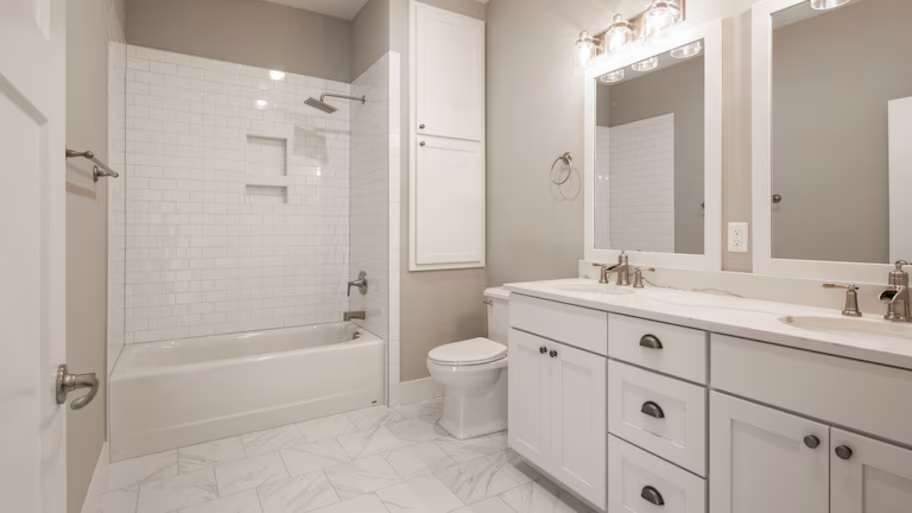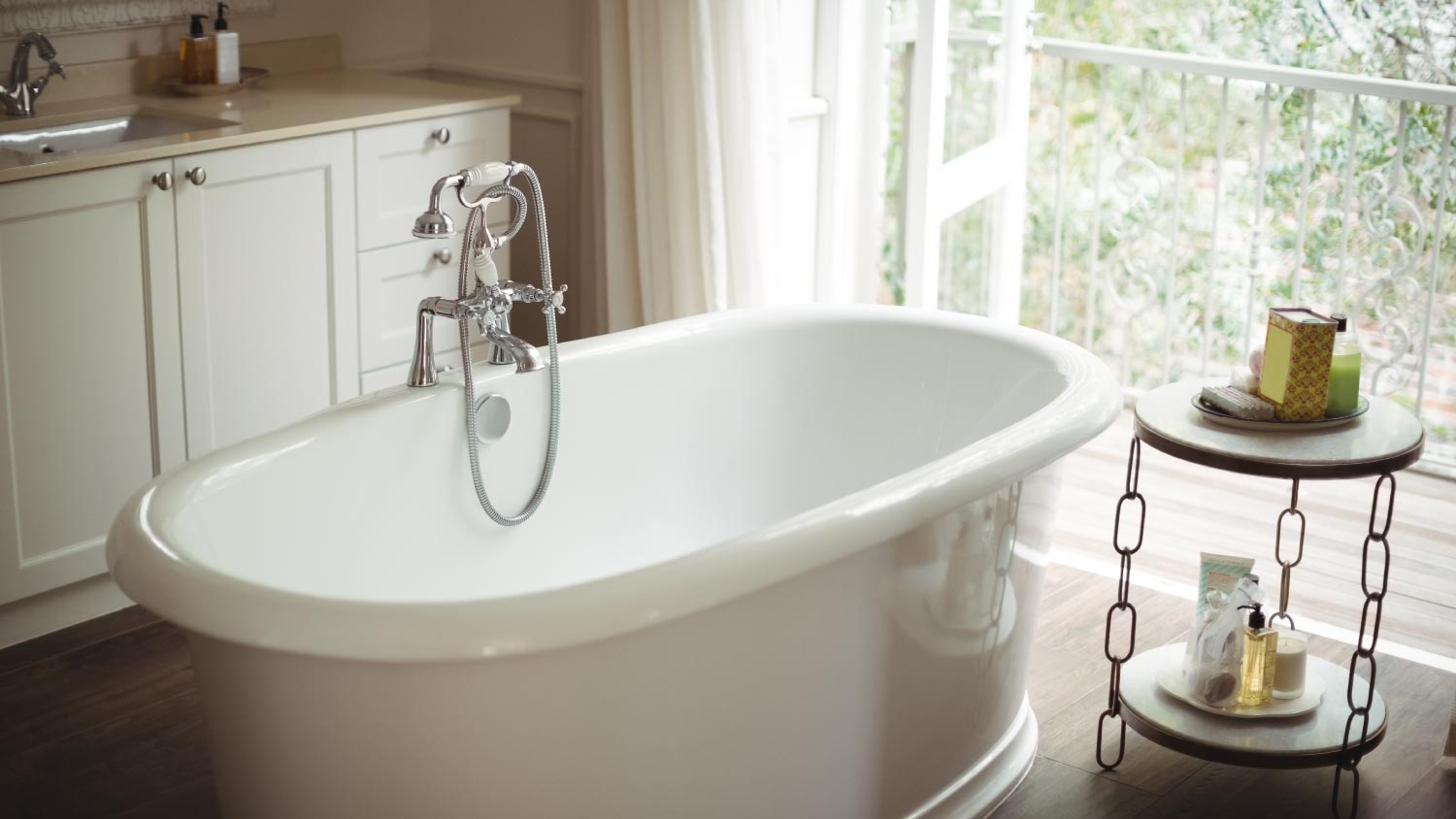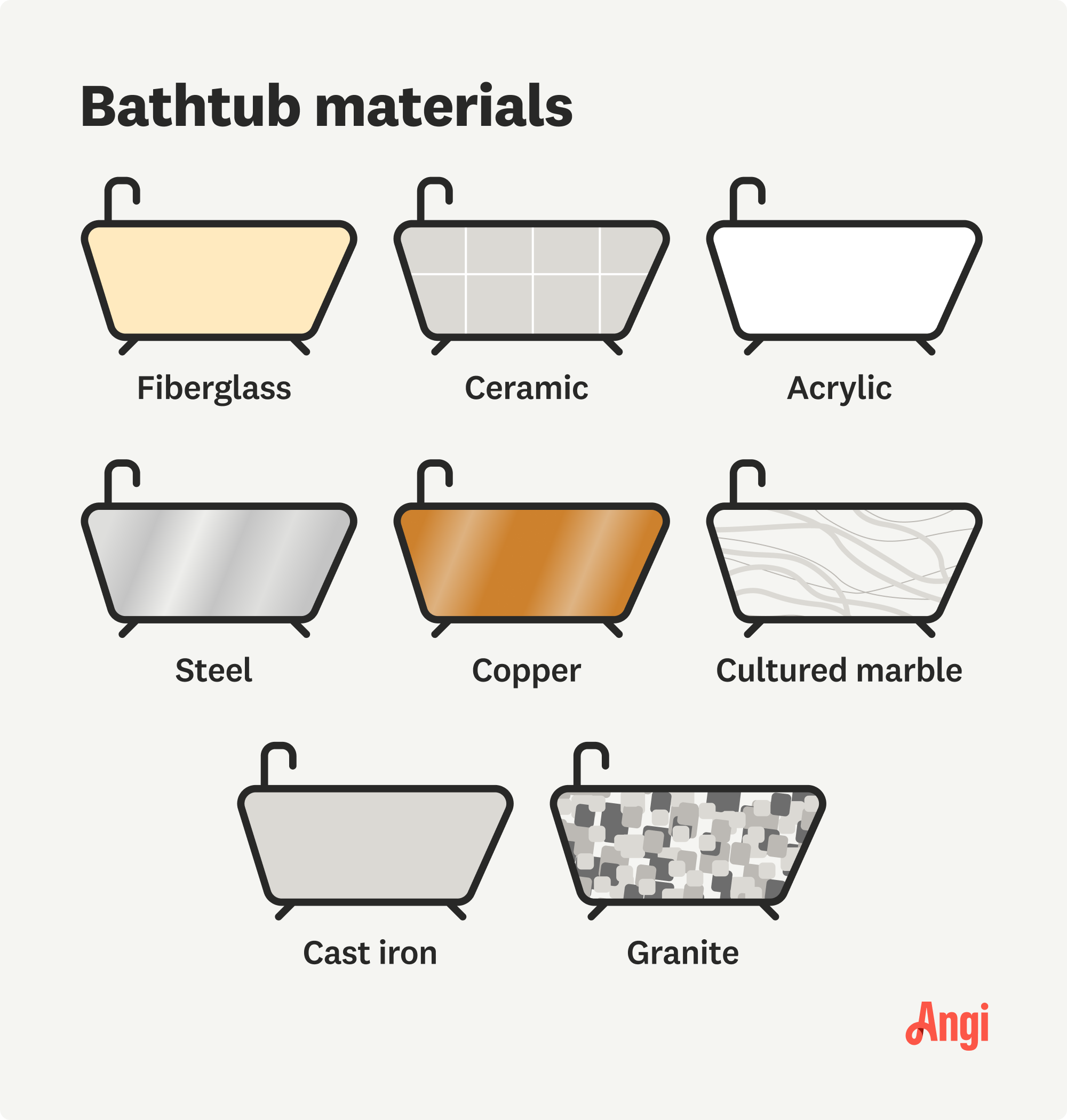
Curious how much a shower remodel costs? From new fixtures to full installations, we have the prices you need to know to establish a shower remodel budget.
Replacing a bathtub in Los Angeles, CA, costs between $828 and $1,692, on average, depending on the materials you choose. A bathtub installation pro can provide a quote for your specific project.


LA's higher cost of living means bathtub replacement can run 15% to 20% above national averages, driven by premium labor rates and strict building codes.
Plumbing permits are required in Los Angeles for any bathtub replacement involving water line modifications, with a minimum fee of $40.
Bathtub replacements in LA yield an average return on investment (ROI) of 70% to 75%.
Replacing a bathtub in Los Angeles, California costs more than in other parts of the country, reflecting the city’s premium labor rates, strict building codes, and logistical challenges of working in a sprawling metro area. Bathtub replacement costs about $1,260 on average here, ranging between $828 and $1,692 for most homeowners. Factor in LA-specific considerations like permit fees and potential seismic retrofit requirements for older homes.
Material choice and tub style make the biggest impact on your final cost for bathtub replacement in Los Angeles, California. On the bright side, the city's year-round mild climate means you can schedule your project almost any time without weather delays.
Many tub styles balance aesthetics and utility to bring comfort and relaxation. Here’s a look at average prices for different bathtub types.
| Tub Style | Average Cost |
|---|---|
| Standard | $200–$1,500 |
| Soaking tub | $600–$13,000 |
| Jet and Whirlpool | $1,000–$4,000 |
| Freestanding | $2,000–$6,000 |
| Walk-in | $4,000–$22,100 |
| Accessible | $4,000–$12,000 |
| Clawfoot | $1,500–$10,000+ |
A standard bathtub is one of the least expensive options, with costs ranging from $200 to $1,500, depending on the tub material. General-purpose tubs are rectangular or oval-shaped and have a showerhead above. You may also need to install a surround for an additional $500 to $2,000.
Deep-basin soaking tub costs range from $600 to $13,000. Like other styles, the price of soaking tubs is mainly determined by material and size. Because these are deeper than standard tubs, confirm that the tub will fit your space before purchasing.
Bathtubs with jets help soothe stiff muscles and sore joints. The average Whirlpool-style tub costs $1,000 to $4,000, and these come in a variety of shapes and sizes to fit your needs. Jets require electricity, so additional work is required to install these tubs, which means higher labor costs and possibly a more substantial remodel.
Freestanding bathtubs have space to move around on all sides. They make for a distinctive element to your bathroom, especially if you’re accustomed to traditional built-in tubs. Freestanding tubs average $2,500, but ensure you have enough space before committing.
Walk-in tubs offer safety and comfort features, including a door, and allow for easier access for older adults and people with disabilities. They cost between $4,000 and $22,100 and can increase your home’s value.
While walk-in tubs offer one form of accessibility, accessible bathtubs can offer more features (including walk or slide-in functions). Most accessible bathtubs are larger and may include a wider, sometimes motorized, entryway. The cost of accessible bathtubs ranges from $4,000 to $12,000.
Distinctive clawfoot tubs can cost $1,500 to $10,000 or more, but you can find options that fit just about any price range. Depending on the material used, the job may require flooring reinforcement.

The bathtub material you choose is a major factor in how much it costs to replace a bathtub.
| Material | Average Cost | Pros | Cons |
|---|---|---|---|
| Fiberglass | $200–$1,000 | Lightweight; affordable | Doesn’t retain heat |
| Ceramic | $5,000–$10,000 | Unique design | Can chip |
| Acrylic | $700–$3,000 | Lightweight; durable | Discoloration |
| Steel | $200–$1,000 | Lighter than cast iron | Loud; can chip |
| Copper | $2,000–$5,000 | Durable; mold-resistant | More costly |
| Cultured marble | $2,000–$5,000 | Stylish | Heavy; can crack |
| Cast iron | $400–$14,000 | Durable | Heavy |
| Granite | $10,000–$20,000 | Aesthetic | Heavy; difficult to install |
Fiberglass tubs are well-suited for Southern California’s year-round warm weather. They’re affordable, lightweight, and come in a variety of colors. You'll pay between $200 and $1,000 to install a new fiberglass bathtub. Unlike some other materials, fiberglass is not great at retaining heat.
Adding a ceramic tub to your bathroom costs anywhere from $5,000 to $10,000, with prices varying based on the colors and styles of ceramic tile you choose. Ceramic tubs offer unique bathtub design choices, but you will have to clean the grout and repair chips.
Acrylic is a popular material for Los Angeles families as it's less likely to warp in the year-round heat. Standard acrylic tubs cost $700 to $3,000, with high-end models approaching $14,000. Opt for acrylic for a lightweight, durable bathtub option.
Enameled steel is a lighter and more cost-efficient alternative to cast iron, with a price range of $200 to $1,000. However, steel drawbacks include the risk of chipping, and they can make a cacophony of sounds while filling.
Copper bathtubs cost $2,000 to $5,000. In addition to its chic appearance, copper is a durable, long-lasting material that’s resistant to mold and bacteria. This material also holds heat well, making it ideal for long, hot baths.
Stylish marble makes for a show-stopping bathroom. Installing a marble tub will run between $2,000 and $5,000. Unlike acrylic, marble is heavy and susceptible to cracks. Ask your pro about extra care and reinforced flooring when you opt for marble.
Porcelain enamel-coated cast-iron tubs come in a range of styles to fit your dream bathroom. They retain heat well, but cast iron is heavy and may require extra reinforcements. Cast-iron bathtubs cost between $400 and $14,000.
The best part of a cast iron tub is the lack of noise and high rigidity. There’s no flex or anything like that.
If you want a bathtub that doubles as modern decor, you can install a granite tub for $10,000 to $20,000. This material is incredibly durable and long-lasting, but can be heavy and difficult to install.
Removing the old tub and inserting the new one isn’t always as easy as it sounds, and there are plenty of additional costs.
| Additional Projects | Average Cost |
|---|---|
| Tub removal and disposal | $50–$300+ |
| Shower-to-tub conversion | $2,000–$10,500 |
| Subfloor prep and reinforcement | $300–$800 |
| Surround | $500–$2,000 |
| Bath liner | $2,700–$10,000 |
| Faucets | $50–$900 |
| Electrical upgrades | $1,600 |
| Water damage repairs | $450–$14,000 |
The cost to remove and dispose of an old bathtub depends on its type. Fiberglass tubs, which are lighter in weight, cost $50 to $100 to remove. Hauling away a heavy cast-iron bathtub could cost $300 or more.
Converting a shower into a bathtub costs $2,000 to $10,500, similar to typical tub-to-shower conversion cost estimates. You’ll need to remove the shower—and since tubs are larger than showers—you might have to remove walls, relocate plumbing, or move electrical wiring to make room for a tub.
Heavy tubs need structural support underneath, which can cost $300 to $800. Repairing floor joists costs $4,000 to over $12,000, depending on the condition of the existing floor joists. The cost of subfloor replacement due to damage under your old tub is $3 to $10 per square foot, but your bathroom remodeling project may not require it.
Installing a bathtub surround costs about $500 to $2,000. For bathtub-shower combos, you’ll want to install a surround consisting of waterproof panels to protect the drywall from shower water.
Bath liners cost about $6,400 on average, but they range from $2,700 to over $10,000, depending on the size of your existing tub. A bath liner is a customized acrylic layer that fits over an existing tub to give it a new look and feel.
Adding a new faucet or other bathtub hardware costs an average of $50 for basic options to over $900 for hardware made from copper or porcelain. You can spend over $700 for high-end faucets, like waterfall or spa-style faucets.
Upgrades to an electrical panel cost $1,600 on average. You may also need to upgrade or add electrical wiring to your bathroom. This may be necessary if you install a jetted or Whirlpool-style bathtub or a tub with high-tech features, like lighting or speakers. If you’re adding a jetted tub, you’ll need a ground fault circuit interrupter (GFCI), which costs an average of $210 to install.
When you take out the old tub or shower, you may encounter water damage in the floors or walls. Water damage restoration costs an average of $3,850. Smaller cases cost around $450, while extensive damage and repairs can cost over $14,000.
You may choose to refinish or replace a bathtub, depending on its condition. Refinishing involves sanding the tub and coating it with primer and paint to remove any small dents or scratches and give it a clean and fresh appearance. Bathroom contractors can complete the refinishing process in a day, and it costs an average of $480.
If your bathtub is severely damaged or has major leak issues, it might not be in good enough shape to refinish, making bathtub replacement a better option. If leaks have damaged the flooring or surrounding wall, you’ll need to make repairs and remove mold. Depending on the new tub, you might need to reroute plumbing to make the bathtub replacement work. Bathtub replacement is another job for a qualified bathroom contractor and possibly an electrician or plumber.
Labor represents a significant portion of your bathtub replacement budget in Los Angeles. The city's high cost of living translates directly to higher contractor rates, with skilled bathroom remodeling pros commanding premium prices.
Bathtub installers in Los Angeles charge up to $160 per hour, well above the national average, plus a minimum service call fee of up to $200 that includes the first hour. The labor cost to replace a bathtub is about $200 to $2,000, but costs go higher if you relocate plumbing lines, remove or install a heavy bathtub, or make repairs to subflooring. Because LA traffic is legendary, expect contractors to factor in longer travel times and potentially higher delivery fees for materials.
If you’re installing a different type of tub than the existing one or placing the new one in a different spot, you might need some plumbing work. Budget $400 to $1,900 to move plumbing lines and pipes. When deciding who to hire for a bathroom remodel, look for a pro who has experience with similar projects.
The Los Angeles Department of Building and Safety (LADBS) requires plumbing permits for changes to drains and potable piping. Building permits cost $50 to $500 for plumbing or electrical work, like new circuits for jetted tubs. Los Angeles County Public Works charges $40 for issuing each permit, plus individual permit-specific fees.
The permitting process in LA can take several days to a couple of weeks, so factor this timeline into your project schedule and cost to demo a bathroom. Ask your contractors about the necessary permits, and don’t start work until you secure them, even if you’re DIYing.
Los Angeles sits in an earthquake-prone region, and older homes may need seismic retrofits during major bathroom renovations. While replacing just a bathtub typically doesn't trigger comprehensive seismic upgrades, inspectors may require certain reinforcements if you're opening walls or modifying floor structure. This can add considerably to your bathroom remodel cost estimate.
Southern California's water conservation mandates affect bathroom projects. It's worth considering low-flow fixtures when you upgrade faucets and showerheads. Many LA homeowners also deal with hard water, which can affect certain tub materials over time. Ask your pro about water softener compatibility if you're installing a jetted tub or choosing materials like copper that interact with water chemistry.
Bathtub replacement can boost your home's value in the competitive Los Angeles real estate market, though the return on investment (ROI) depends on the scope and quality of your upgrade. Homeowners average a 70% to 75% ROI for midrange bathroom remodels, but a straight tub replacement alone returns less value.
Luxury upgrades like freestanding soaking tubs or jetted models resonate with buyers in upscale areas like Beverly Hills or Manhattan Beach, where high-end finishes are expected. However, in more modest neighborhoods, a standard acrylic or fiberglass tub replacement offers better value than a premium granite model.
In LA's older housing stock, replacing a deteriorating tub addresses potential mold issues and plumbing failures before they become major problems. This preventive maintenance protects your investment and gives buyers confidence that the home's systems are sound.
Home is the most important place on earth, which is why Angi has helped more than 150 million homeowners transform their houses into homes they adore. To help homeowners with their next project, Angi provides readers with the most accurate cost data and upholds strict editorial standards. We survey real Angi customers about their project costs to develop the pricing data you see, so you can make the best decisions for you and your home. We pair this data with research from reputable sources, including the U.S. Bureau of Labor Statistics, academic journals, market studies, and interviews with industry experts—all to ensure our prices reflect real-world projects.
Want to help us improve our cost data? Send us a recent project quote to [email protected]. Quotes and personal information will not be shared publicly.
From average costs to expert advice, get all the answers you need to get your job done.

Curious how much a shower remodel costs? From new fixtures to full installations, we have the prices you need to know to establish a shower remodel budget.

Building a guest house is one of the largest home projects and involves several different professionals. Learn about the cost to build a guest house and where you can save.

Remodeling your bathroom can add significant value to your home. Your bathroom remodel cost in Columbus, OH will depend on size, fixtures, materials, labor, and other factors.

Knowing how to install a shower requires some skill and experience, but a shower enclosure installation is a doable DIY project if you follow some basic steps.

From increasing resale value to being tricky to maintain, there are plenty of pros and cons of copper kitchen sinks. Figure out if they’re right for you.

DIY sink installation is a doozy but do-able for those with experience. Use this guide to learn how to install a bathroom sink in a few steps.